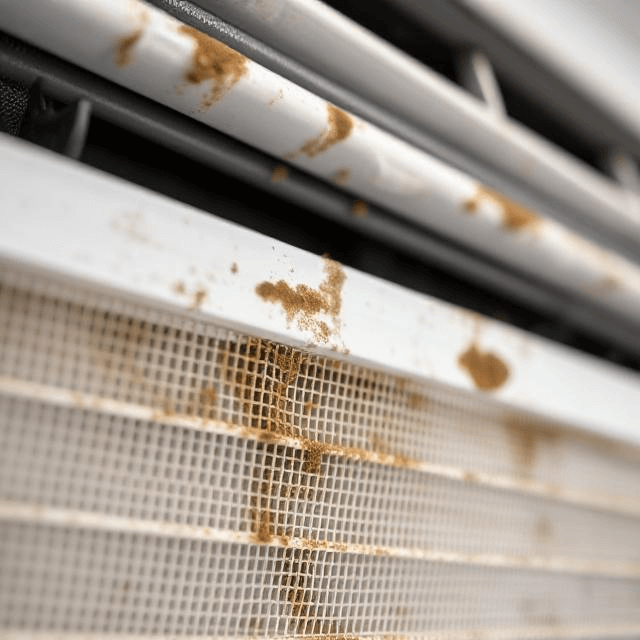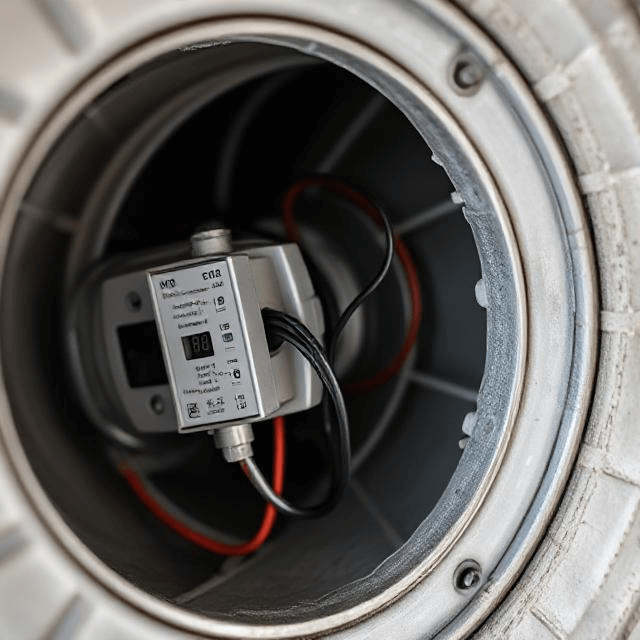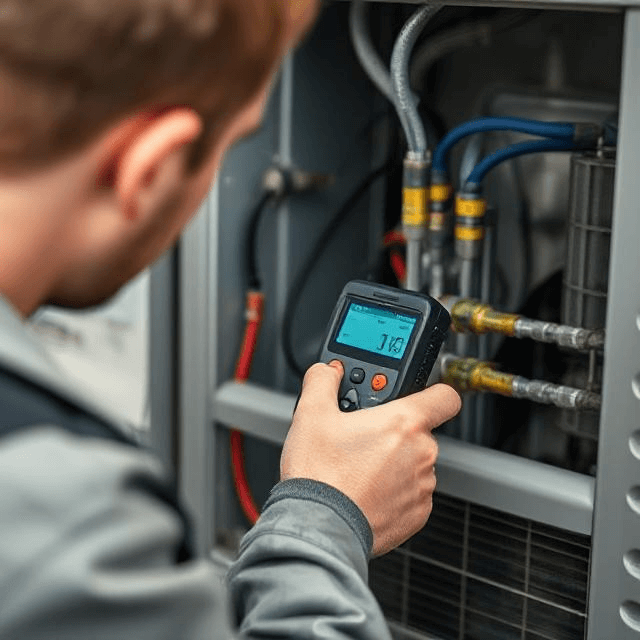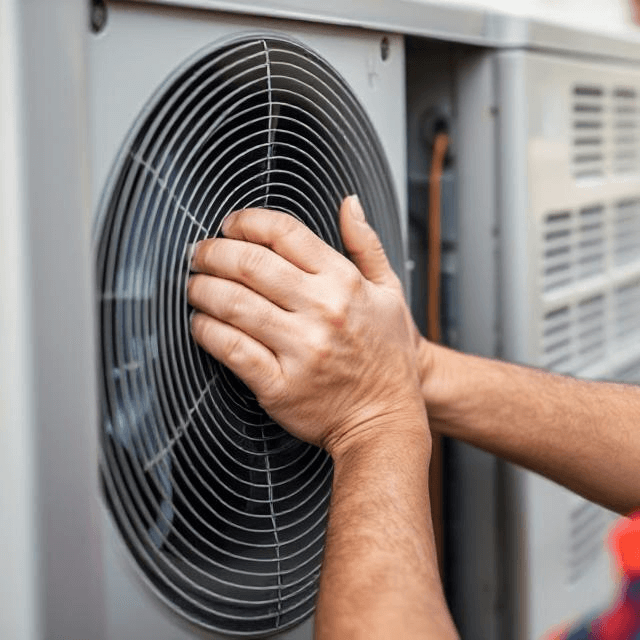Check your AC regularly for mold by inspecting the air filter, evaporator coils, and ductwork for any visible mold or dampness. If you spot any mold, clean or replace affected parts to prevent the mold from spreading and affecting indoor air quality.
This guide covers the steps in detail to help you thoroughly inspect the air conditioning unit.
Click below to jump right in:
- Step-by-Step Guide to Inspecting Your Air Conditioning Unit for Mold
- What to Do If You Find Mold in Your Air Conditioner?
- When to Call a Professional HVAC Technician
For professional air conditioner maintenance service, call Season Control Heating & Air Conditioning at 818-275-8487. We serve Canoga Park, CA, and nearby areas.
Step-by-Step Guide to Inspecting Your Air Conditioning Unit for Mold
1. Turn Off the Air Conditioning Unit Before Inspection
Turn off the AC before starting any inspection. This ensures your safety and prevents the system from running accidentally during inspection. It also gives you a clear view of the components without the risk of moving parts.
2. Look for Signs of Mold Problem
Before inspecting the individual components of your air conditioner, pay attention to general signs that mold may be present. Musty odors, excessive moisture around the unit, or recurring allergy symptoms such as sneezing or coughing can all indicate mold growth. If you notice any of these symptoms, it’s a strong signal that mold could affect your AC unit.
3. Check the Air Filters for Mold or Mildew Buildup
The air filter is one of the most common places where mold builds up. Remove the filter and inspect it for visible mold or mildew. If the filter is damp or has a musty smell, it could indicate mold growth. A dirty or moldy filter can also compromise air quality, so cleaning or replacing it is necessary.
4. Inspect the Evaporator Coils for Moisture
The evaporator coils are a key area where mold tends to grow. These coils cool the air and can collect moisture, creating a perfect environment for mold to thrive. Use a flashlight to carefully check the coils for any visible mold or moisture buildup. If you find mold, cleaning it immediately is crucial to prevent its spread.
5. Examine the Air Ductwork for Signs of Mold Infestations
Mold can also grow inside the ducts, especially with trapped moisture. Check any accessible ductwork for visible mold, paying close attention to areas near the vents. If you notice mold or unusual discoloration, it may be time to clean the ducts.
6. Look for Water Leaks Around Your HVAC System
Water leaks around your AC unit can contribute to mold growth. Inspect the area around the unit for any signs of leaking water, especially near the base or the drain pan. Leaks provide a constant moisture source, creating an ideal environment for mold. If you find leaks, repair them immediately to prevent mold from spreading.
7. Check the Drip Pan and Drain Line
The drip pan collects condensation from the AC unit. It can quickly become a breeding ground for mold if it isn’t draining properly. Make sure the pan is clean and draining as it should. If it is full or has standing water, empty it and inspect the drain line to ensure it’s clear and fully functional.
What to Do If You Find Mold in Your Air Conditioner?
If you discover mold in your air conditioner, it’s essential to act quickly to prevent further damage and maintain healthy air quality.
Here’s what you should do:
1. Clean Mold from the AC Unit
The first step in mold removal is cleaning the affected areas. For mold growth on air filters, evaporator coils, or air vents, use a cleaning solution especially designed for HVAC systems or create a mixture of vinegar and water. Wipe down visible mold and ensure thorough cleaning of all components.
2. Replace Air Filters
Replace air filters if they are contaminated with mold. A moldy air filter reduces the effectiveness of your air conditioning system and contributes to the spread of mold spores throughout your home. When replacing the filter, choose a high-efficiency particulate air (HEPA) filter, which helps capture mold spores and improve the air quality in your home.
3. Inspect and Clean the Evaporator Coils
If mold is found on the evaporator coils, clean them carefully to avoid damaging the delicate components. Due to their moisture accumulation, the coils are a common area for mold buildup. Regular maintenance, such as using an HVAC cleaner or contacting an expert for servicing, can prevent mold from returning.
4. Address Humidity Levels
Mold thrives in environments with high humidity levels. To prevent future mold growth in your AC units, ensure that your home’s humidity is controlled. A dehumidifier can help manage moisture levels, especially in mold-prone areas like basements and bathrooms.
5. Schedule Regular Air Duct Cleaning
If the mold is present in the air ducts or has spread throughout the air conditioning system, consider scheduling professional air duct cleaning. Mold spores can travel through your HVAC unit and contaminate the air supply. Cleaning the ducts will help eliminate mold spores and prevent them from spreading.
6. Consider Professional Mold Remediation
In cases of extensive mold infestations, it’s best to call a professional for mold remediation. They have the proper equipment and expertise to clean mold from the entire HVAC system and minimize the risk of health issues.
7. Repair Water Leaks
Water leaks around the AC unit or within the air conditioning system can worsen the mold problem. Check for leaks in the drain pan or along the drain line, and repair any damaged parts immediately.
When to Call a Professional HVAC Technician
If you’re unsure about your ability to clean the AC unit thoroughly or if the mold problem is widespread, it’s best to call a licensed HVAC technician. Here are signs you may need professional help:
- If mold is spread throughout your HVAC system, especially inside the ducts or coils.
- If the mold infestation is larger than 10 square feet.
- If the mold returns despite cleaning.
- If your health or your family’s health is affected by mold exposure (e.g., respiratory issues, allergies).
- If you can’t access or clean the internal parts of the AC unit effectively.
An HVAC technician can perform a comprehensive inspection, clean all components, and ensure the system functions efficiently and safely. They also have the knowledge to fix any underlying issues contributing to mold growth, such as leaks or inadequate humidity control.
Take Action Against Mold Growth in Your AC Units!
Regularly inspect your air conditioners for mold growth to maintain air quality and prevent further damage to your HVAC system. Prompt action helps you avoid costly repairs and ensures a healthier indoor environment.
Call 818-275-8487 if you suspect mold in your AC or need professional HVAC maintenance. Our team of certified, licensed, and insured technicians ensures the highest level of service and safety when handling your HVAC system. We proudly serve Canoga Park, CA, and surrounding areas.
FAQs
Can AC mold make you sick?
Yes, AC mold can make you sick. Mold exposure in your air conditioning system can lead to respiratory issues, allergies, and worsen asthma symptoms. Prolonged exposure to mold spores can also cause headaches, coughing, and irritation in the eyes, nose, or throat.
How do high humidity levels contribute to mold growth?
High humidity levels create an environment where moisture accumulates, allowing mold spores to thrive. When the air is too damp, mold can grow on surfaces like walls, ceilings, and HVAC systems.
How long does mold removal last?
The effectiveness of mold removal depends on the extent of the problem and how thoroughly the source of moisture is addressed. With proper treatment and regular maintenance, mold removal can be long-lasting. However, mold could return if humidity levels or leaks aren’t controlled.









